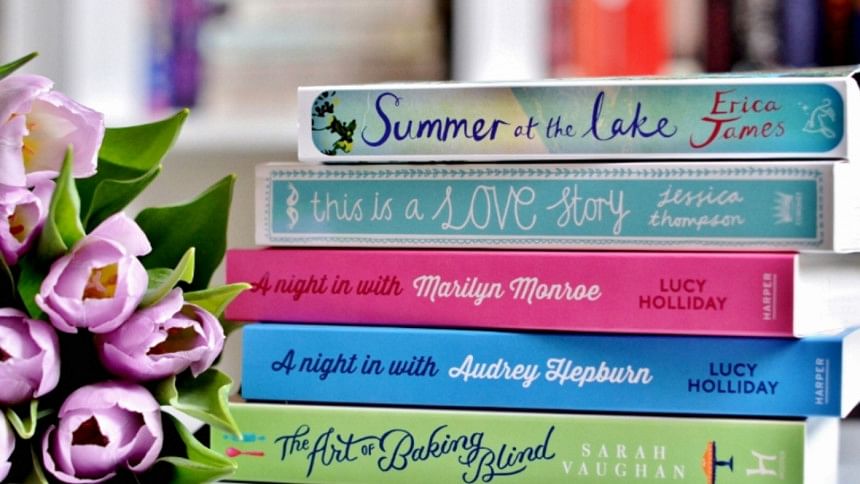In defence of ‘chick-lit’

A portion of my bookshelf looks "girlier" than the others. It's stacked with hardbacks and paperbacks in various shades of pink, pale yellow, glittering gold, and some pops of red and purple. Anyone who walks in and looks at this section of the shelf will know immediately that it contains different variations of love stories, of stories about girls going on holiday and bonding with their girlfriends and reconnecting with themselves, usually having cast off a toxic job or relationship. Think of your Nora Roberts, your Cecelia Aherns and Jojo Moyeses and, if you like to step back in time, your Judith McNaughts.
But here's the thing—as loved as these authors all are, the kinds of stories they write too often get cast off into the "light fiction" genre. Fiction that isn't important. They hardly make it to critical reviews alongside other literary fiction, they hold relatively limited presence at literary festivals and panels, and they don't make it as easily to the prescribed reading lists or the titles we list when bragging about our reading tastes. The underlying premise behind this norm is one that smirks at a genre that is often smart, witty, uplifting and, in many ways, empowering for its readers. This prejudice perpetuates, through the very terms "chick-lit" (an infantilising name) and "women's literature", the toxic ideas that matters of the heart and stories about relationships—stories that actually make you happy or cater specifically to human emotions—are meant only for the eyes of women; that stories enjoyed by women should be an entirely separate and somehow less respected brand of literature.
Gerard Genette, the French literary theorist, was fascinated with how a book's "paratexts"—every part of a book besides the text proper—influence the way it is perceived. In "Paratexts: Thresholds of Interpretation" (1987), he wrote how the cover with all its elements of colour, font, illustration, and publisher's emblem can indicate to an audience what kind of book it is. In early 20th-century France, for instance, yellow covers denoted "licentious" books (which eventually inspired the title of Aubrey Beardsley's scandalous quarterly The Yellow Book). Nowhere is such an influence of the book cover more noticeable than in what we think of as chick-lit.
Author Maureen Johnson made an experiment out of this for the Huffington Post in 2013. Her article "Coverflip: Gendered Book Covers Turned Around" reimagined popular classics if they were written by and for women—"Georgette" R Martin's "A Game of Thrones" featured the mother of dragons standing against a purple horizon decorated with gold curlicues, and "Nellie" Gaiman's "Stardust" featured an image of a woman locked blissfully in a man's embrace, among other famous titles. The images evoked a striking message about how we automatically perceive a story as far more "feminine" with a simple shift in cover design. Add in some bright or pale colours, some curled or chalky fonts and/or a picture of a woman or her belongings—boots, jewellery, dresses, makeup—and the overall image is one that advertises its content as light literature comprising syrupy prose and two-dimensional stock characters.
Some of these tropes are obviously true. Literary fiction is revered because it often experiments with form and content; because it fleshes out incomplete, flawed characters whose struggles often remain unresolved at the end of the text. Such books push the reader to read differently, to think differently about both the possibilities of a novel and the world around her. "Chick-lit" novels, on the other hand, usually portray a Bridget Jones-type character whose troubles almost always find a happy ending by the time one turns the final page. The genre also has a glaring flaw—it almost entirely portrays straight white women living in the West in leading roles. Luckily, that trend is slowly shifting, with queer characters and characters of colour commanding their presence in many novels.
These books (the good ones at least) offer more than just fluffy escape. In the absence of a challenging form and language, such stories offer enough comfort and optimism that the reader is able to absorb some strength from their characters. Camus' Mersault may evoke a thought or two about the pointlessness of the human condition, but Jojo Moyes' Lou taught me far more about finding humour and colour amidst life's worst tragedies. Bridget Jones has taught nearly every teenage girl how to embrace one's bodily imperfections and distinguish between a good and a bad love interest. These stories are relatable and entertaining enough to inspire a love of reading amongst even those too scared to take up the project of finishing an entire novel.
Literature, like all crafts, improves upon practice, upon collective discussion and analysis. Including such stories in reading lists and in critical discussions will encourage far more people to fall in love with reading and find the courage to move on to more challenging forms of literature. It will also motivate writers and the publishing industry to hone and experiment on the form, content, and subject matters of a genre that all but holds its readers' hands through the daily pitfalls of living in this world. I can't think of a more worthwhile accomplishment for a book.
Sarah Anjum Bari is a member of the Star Weekend magazine team, The Daily Star. Reach her at [email protected].

 For all latest news, follow The Daily Star's Google News channel.
For all latest news, follow The Daily Star's Google News channel. 



Comments